State of the Arts

Round and round and round it goes, where it stops, nobody knows. Ginger Lukas MFAx’11 gives her mixed-media project a hearty spin as she contemplates where to place the next element while working in her studio space at the Art Lofts, which opened on campus last year.
The arts give life to whatever the mind’s eye can imagine — and open new ways of looking at our world.
The arts have been woven into the fabric of university life from the earliest years of the campus. Science Hall, which opened in 1877, included an art museum. (Unfortunately, the gallery and the collection were lost in 1884 when the building caught fire and its contents were destroyed.)
But since that inauspicious beginning, instruction in the visual and performing arts has expanded in size and reach, nurturing the creative promise in our students. A robust arts environment sparks new ways of looking at our world — and at ourselves. Today’s students will become tomorrow’s working artists, continuing the legacy.
Nothing compares to learning from a working artist. An interdisciplinary arts residency program, sponsored by the Arts Institute and now in its eleventh year, brings innovative, world-class artists to campus for semester-long residencies with two or more departments. The program exposes students to professionals and builds collaborations among departments, programs, and other campus and community arts entities.
In addition to providing an environment where students can discover and hone their skills, the campus is rich in opportunities to absorb art. The work of faculty, students, and artists with international influence is displayed in galleries in the Chazen Museum of Art, the Wisconsin Union, the Mosse Humanities Building, the Design Gallery, many campus libraries, and the recently opened Art Lofts.
On the performance side, stages in the Mosse Humanities Building, the Memorial Union, the Wisconsin Union Theater, and Vilas, Music, and Lathrop halls are alive with theater, film, music, and dance. Performers range from students and faculty to the brightest stars and leading names in their fields. And don’t forget the Memorial Carillon, with its fifty-six bronze bells and the campus’s very own carillonneur.
The growth of the arts on campus created some firsts for the university. The UW was the first university to offer a degree program in dance — beginning in 1926.
In 1940, the touring musicians of Belgium’s Pro Arte Quartet were stranded in the United States by the outbreak of World War II. The residency they accepted at the UW was the first such program at a major American university. Pro Arte hits the century mark next year.
And the glass program is the oldest among those operating full time on a U.S. campus.
Illuminate: Year of the Arts — designed to spotlight the breadth, power, and purpose of artistic exploration and expression — kicks off on campus this fall. Along with more than thirty featured events, some three hundred performances, exhibits, symposia, public events, publications, distinguished visiting speakers, and online resources will celebrate the arts.
“Throughout the university’s history, the arts have brought richness, depth, diversity, and insight to the campus community,” says Chancellor Biddy Martin PhD’85. “The Year of the Arts will provide opportunities to consider how creative expression frames our vision, enables change, and shapes our lives.”
Gwen Evans ’79 is a senior university relations specialist at University Communications. She tried to get into an art school advertised on a matchbook cover, but was rejected.
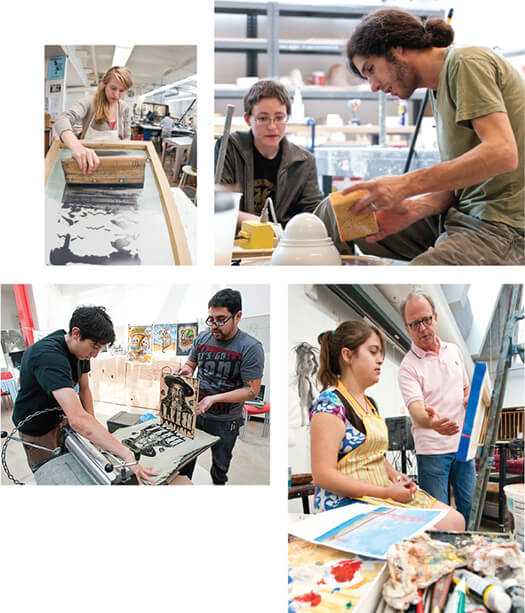
Top left: Like magic, an image appears as Sigrid Hubertz x’12 uses a squeegee in art professor John Hitchcock’s screen-printing class in the Mosse Humanities Building. Top right: Watch and learn. Jacquelyn Whisenant x’12 (left) pays close attention as Paul Sacaridiz, associate professor of art, demonstrates a ceramic technique during a class session focusing on making molds for working with clay. Right: With her tools of the trade close at hand, Yvonne Foy x’13 (left) listens to advice from art professor T.L. Solien during Intermediate Painting class in the Mosse Humanities Building. Above: Have press, will travel. Justin Maes x’12 (left) and Joseph Velasquez MA’06, MFA’07 create a woodblock print on a T-shirt during an event at the Art Lofts in 2009. A few years earlier, Velasquez and Greg Nanney MA’06, MFA’07 created Drive By Press, a design collective that allows them to take their passion for printmaking on the road. They bought a fourteenth-century-style press and have been spreading ink and the art of print- making to audiences across the United States ever since.
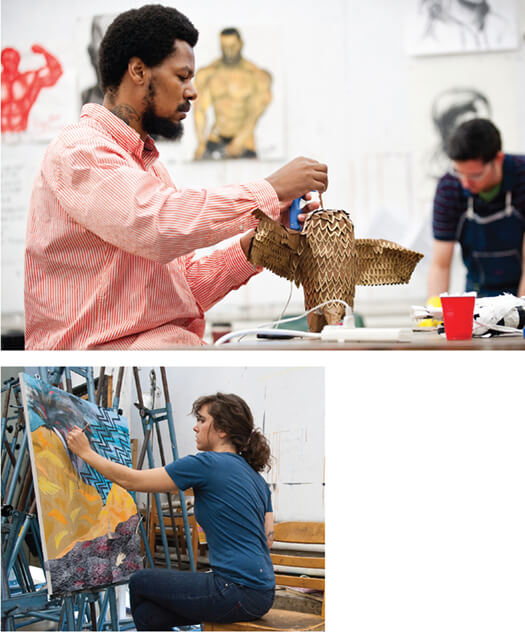
Above: An idea begins to take tangible shape that others can absorb as Comfort Wasikhongo x’12 works on a three-dimensional mixed-media piece in an Intermediate Drawing class taught by faculty associate Michael Velliquette MA’99, MFA’00. Left: For classmate Meg Fransee x’11, the medium of choice is paint as she works on a piece in Velliquette’s Intermediate Drawing class held during Summer 2010. The course explores conceptual drawing in various media.
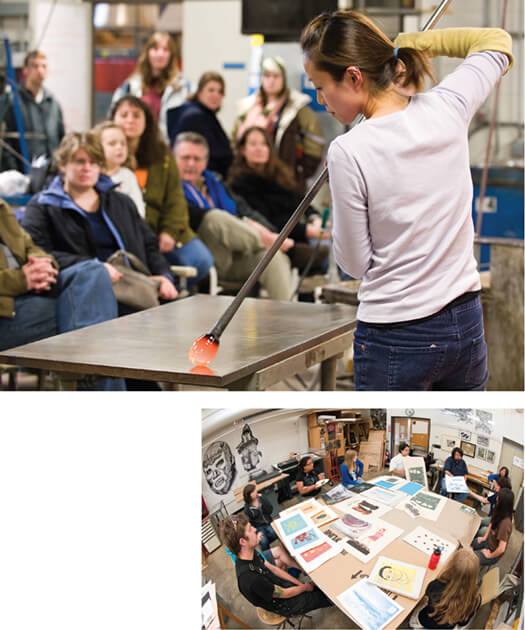
Above: Artist Yuki Wakamiya shapes a piece of molten glass during a demonstration at the glass lab in the Art Lofts, a facility that put an end to the hither and yon for Art Department programs, facilities, and studios when it opened in 2009. All art programs are now housed in just two locations: the Art Lofts, in the former university warehouse facing the Kohl Center, and the top two floors of the Mosse Humanities Building. The Art Lofts facility contains the glass lab, metal sculpture foundry, ceramics, graduate darkroom and digital facilities, and papermaking areas, along with exhibit and studio space for more than sixty faculty and graduate students. Right: Put a bunch of visual thinkers and creators together, and ideas happen. Instead of benches and fume hoods, a space in the Mosse Humanities Building serves as a laboratory for art professor John Hitchcock’s Serigraphy class, where students gather to critique and discuss a screen-printing assignment.
Published in the Fall 2010 issue
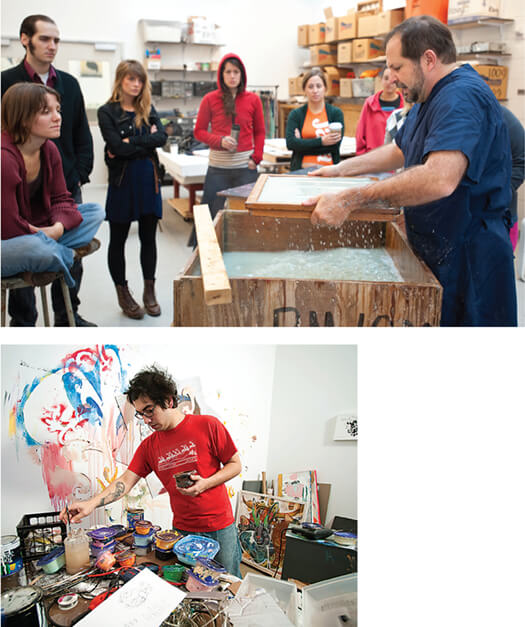
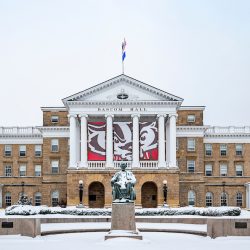

Comments
No comments posted yet.